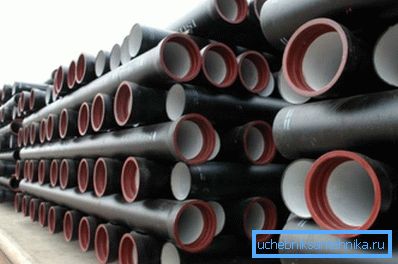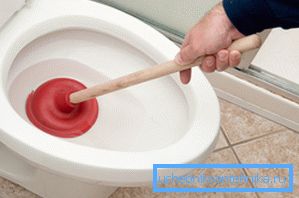Pig-iron sewer pipes: their types and 4 basic operation
Cast iron pipes have been used to create sewer systems for a very long time and, despite the introduction of products from new and more advanced materials into this process, continue to be in service due to their unique qualities. In this article we will consider their technical features and rules for maintenance.

General provisions

Pipes from cast iron according to GOST 6942 98 can be of several types:
| Designation | Type of | Technical features | Spheres of application |
| VCHSHG | Pressure head |
|
|
| Cheka | Free-flow |
|
|
| SML | Socketless |
|
|
| ChNR | Pressure bell-shaped |
|
|
The service life of cast iron sewer pipes is at least half a century, we also see from the table that they have high strength characteristics and even less susceptibility to corrosive processes, in comparison with steel.
But it is worth remembering about a few common negative points:
- Relatively high price. Polypropylene products, of course, are much cheaper, but do not have the same high reliability.
- Heavy weight. This may cause inconvenience in the implementation of installation works with their own hands.
- Some brittleness, which will require caution in the processing of pipes.
Tip: cutting cast iron should be strictly at right angles. So you can avoid the appearance of microcracks and fractures.

Proper treatment
The GOST for the use of cast iron pipes provides detailed data on their operation, but let's further analyze 4 main points:
First: select the diameter

The diameter of cast iron sewer pipes can reach several meters, depending on the place of their use. After all, if we are talking about the urban public highway or a large industrial complex, then there will need a very high performance.
The dimensions of sewage cast-iron pipes used in an apartment or private house are much more modest:
| Plumbing unit | Diameter, mm |
| Washing | 40 |
| Bath | 50 |
| Toilet | 100 |

Second: clearing

How to clean the cast iron sewer pipe? During operation, fats and small insoluble particles settle on the internal walls of the pipeline from any material, which can subsequently form a solid garbage plug.
Cast iron is not an exception, and you should know how to deal with this problem:
| Tool | Mode of application | Total |
| Boiling pot | Pour the liquid into the drain hole | Hot water eats away fat deposits. |
| Vantuz |
| Pressure is formed, which dislodges and partially destroys the mud plug, and the incoming water then completes the cleaning |
| Steel rope |
| Even the strongest seal breaks through. |
Tip: during normal washing with boiling water, it is recommended to add soda or salt to the solution. They greatly increase the effect of fat splitting.

Third: dismantling

Sometimes, replacement of cast-iron sewage pipes with plastic or new ones of the same material is performed. This is due to the fact that the old apartments were equipped just with iron pipelines, the operational period of which in 50 years, many have already passed. At the same time, utmost care should be taken not to damage the general riser.
Instruction for dismantling works is as follows:
- Turning off the water supply.
- Using the key, disconnect the hose that supplies water to the drain barrel.
- Turn off the bolts that fix the toilet to the floor, and remove it.
- Those pipes that are sufficiently removed from the central riser, we break it with a hammer or sledge hammer.
- Remove the pipes connected to the riser, preheating the joints with a gas torch. This will destroy the sulfur compound.

- Carefully clean the socket from debris and grease.
- Install the cuff.
It is also possible, if you want to eliminate the drain hole at all. Then you should think about how to drown the sewage cast-iron pipe? To do this, fit the special plugs sold in plumbing stores.
Fourth: repair

You need to be able to carry out a quick repair of the cast-iron sewage pipe yourself, as the wait for a plumber sometimes results in incredibly long terms.
Three methods are suitable for this, depending on the complexity of the leak:
- If the fistula is small, then it will be enough to cover it with cement, which is in perfect contact with the iron, creating an integral patch.
- If the crack is more noticeable, then soak a liquid cement mortar with a bandage and wrap the pipe with it.
- If the gap is too large, then you will still have to use a special clamp, completely covering the leak.
Conclusion
Cast iron pipes to date are used in the arrangement of sewage. Among them are 4 main types. During operation, some nuances should be taken into account, which we described in detail above.

The video in this article will introduce you to additional materials.